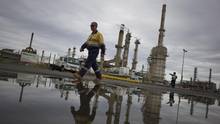A sharp correction in oil prices is putting the debate around major pipeline projects, such as Keystone XL, into a more nuanced light.
Part of the impetus behind constructing new pipelines to carry bitumen from northern Alberta to the U.S. Gulf Coast, Kitimat on the Pacific, or even all the way across the country to Saint John, N.B., was to help close the substantial discount between Canadian oil and world prices. Well, crude’s recent drop into the $85-a-barrel range has basically collapsed the once wide-open spread that had existed between West Texas Intermediate and Brent crude with hardly any new lengths of pipe being laid into the ground at all.
It’s quite a turnaround considering that not that long ago WTI had traded as much as $40 a barrel lower than Brent. The difference between Brent and a barrel of Western Canadian Select, the benchmark price for oil sands product, was even more significant, a fact that had caused considerable hand-wringing in downtown Calgary as well as on Parliament Hill.
Oil sands players, as well as U.S. producers in North Dakota, have been clamouring for pipeline approvals, claiming that all of the political foot-dragging around pipeline projects weakened pricing power and critically hampered their operations. While those producers are still waiting for new pipelines to be built, the price of a barrel of WTI and Brent crude are now trading within a few dollars of each other (in part due to the rapid emergence of oil by rail).
It’s a development, however, that won’t be causing any champagne corks to be popped in the boardrooms of Suncor or Canadian Natural Resources. Canada’s oil patch suddenly has bigger fish to fry than figuring out how to get its oil to tidewater. The worry now is what’s happening to the global oil prices, which they’ve been coveting.
The world looks much different from the days since multibillion-dollar pipeline projects such as Northern Gateway and Keystone XL were first proposed. Both Brent and WTI are trading below $100 a barrel and it won’t be long before they fall below $80. If you doubt that outlook just note what Saudi Aramco did earlier this month. Instead of cutting back production by several million barrels a day to support prices like they did in 2008 and 2009, the Saudis instead chose to protect their market share by slashing prices.
For those wondering about the future direction of oil prices, the behaviour of the world’s most important oil supplier and lead member of OPEC is instructive. Saudi Aramco has now cut all of its export prices, reducing prices to Asian markets to their lowest levels since the 2008 recession.
It’s not hard to figure out where this is going for oil sands producers. When commodity prices fall, whether it’s coal, iron ore, copper or otherwise, the effect on supply is the same. Falling prices hit high-cost producers first and hardest. Guess what’s happening in the oil sands right now?
In the last several months alone we’ve seen two major announcements of shelved or cancelled projects. Total SA is walking away from its Pierre River project, while Norway’s Statoil is doing the same from the Joslyn mine. In light of the current outlook for oil prices, such decisions aren’t a surprise.
Even production from prolific shale plays like the Bakken, which straddles North Dakota and southeast Saskatchewan, are at risk. At price levels below $80 a barrel, you can expect to see the current frantic pace of drilling in the region start to gear down.
For pipeline companies with major proposals on the table, such as TransCanada and Enbridge, falling oil prices are a game-changer of the same magnitude that rising prices were a decade ago. Back then, soaring prices created an urgent need to build new pipelines to connect North America’s burgeoning supply to coastal refineries and world markets.
We’re now in a different world. At the root of today’s problem is global demand that is no longer growing quickly enough to support the prices necessary to keep expanding expensive unconventional sources of supply such as the oil sands. Lower prices will effectively strand those reserves regardless of the transportation options that may become available. Even if President Obama approved Keystone XL or the National Energy Board gave the green light to Energy East, falling commodity prices mean that soon there might not be enough oil flowing out of northern Alberta to fill those new pipelines.
Plunging oil prices a game-changer for major pipeline projects

























Laissez un commentaire Votre adresse courriel ne sera pas publiée.
Veuillez vous connecter afin de laisser un commentaire.
Aucun commentaire trouvé